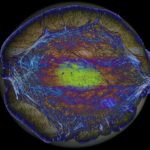Cite as: Benner, S. A. (2022) “NASA Headquarters Misses the Ball. Polyelectrolytes as the Key to Agnostic Life Finding”. Primordial Scoop, e20220416. https://doi.org/10.52400/UJPI9051
In 2018, Mark Neveu and his colleagues at NASA Headquarters published a “ladder” to evaluate claims that alien life has been detected. It was a clever idea, adapting the “technical readiness level” format familiar to NASA engineers designing flight instruments. How far up the ladder your observations go suggests how likely your “detection” might be.
The 2018 Headquarters review did a good job representing the state-of-the-art of non-Terran life detection. Yes, most of it was classical, dating back to the 1960’s. However, the review also found space to mention some 21st century life detection concepts…
…including one of my own.
But then Headquarters got it wrong.
As those who frequent this blog know, 30 years of synthetic biology creating alien informational systems has taught us that DNA and RNA are far from being the only linear polymers that might support Darwinian evolution. And since theory holds that Darwinian evolution is the only mechanism to generate systems that display the properties that we value in life, many informational polymers can support life.
However, synthetic biology also taught us that two features are universal in those polymers:
(a) They must have a repeating negative charge, negative (like DNA) or positive. They must be polyelectrolytes. This ensures that any mutation does not cause major changes in the molecule’s chemical properties. This, in turn, ensures that new information arising from replication mistakes can be propagated if it improves fitness.
(b) Their informational building blocks must be size/shape interchangeable. They must all fit into an “aperiodic crystal”, a term introduced by Erwin Schrödinger 80 years ago. This allows the physics of phase transitions to ensure that mutations are infrequent.
An Agnosic Life Finder (ALF) uses (a) to concentrate scarce informational biopolymers, likely to be at (very) high dilution in environments where resources are (very) sparse.
Thus, a Science Traceability Matrix must ask: How do you engineer an ALF instrument to meet one of the two central challenges in non-Terran life detection: Aliens are likely to be sparse in any sample likely to be collected by NASA.
So what did Headquarters get wrong? Let’s quote the relevant passages from the 2018 review, in italics, with interspersed comments.
” Polymers with a repeating backbone charge such as DNA and RNA facilitate Darwinian evolution by being able to undergo mutations (e.g., in nucleobases) that do not cause major changes in their chemical properties, dominated in liquid water by the repeating charge.”
Pretty good! The Polyelectrolyte Theory of the Gene says that informational polymers must have a repeating backbone charge, not just to “facilitate Darwinian evolution”, but as a requirement for it in water. A bit weaker as a statement than we would like, but good enough for now.
But NASA Headquarters continues:
“There is currently no method to detect a repeating backbone charge, but a polycharged detector may be implemented (Benner, 2017).”
Disaster! Headquarters misses the point. ALFs do not work by detecting polyelectrolytes. Rather, ALFs exploit the universal polyelectrolyte feature of all informational polymers to concentrate Darwinian polymers. After concentration, detection can be done by pretty much any method.
We, of course, recommend that the detection step also examine the concentrated polymers to see if they are composed of Schrödinger’s size/shape regular building blocks. Mass spec with fragmentation is one way to do this.
How did Headquarters make this mistake? We start with the title of its paper, which says that its authors are interested in detection. And if you start out with detection as you goal, you are likely to superimpose a detection requirement on any new idea, even if the idea has nothing to do with detection, but rather is offered to solve a concentration problem.
To make the point so it cannot be missed (again), use an analogy to the old Aesop fable. When training a child: “Make your first lesson obedience, the second lesson can be what you chose.”
For life detection, make your first task concentration. Then, the detection strategy can be whatever you choose.
But the good news-bad news continues:
“A repeated charge is difficult to mimic abiotically (#6) and more generic than DNA or RNA (#7). The “#” refers to a step in the ladder.
Good news. Yes, I would have preferred text stating instead that a polyelectrolyte heteropolymer with size/shape regular building blocks cannot be sustained without Darwinian evolution. But two critical concepts are here, that (i) this chemistry does not allow false positives, and (ii) we need agnosticity.
But then comes the bad news.
However, as with DNA and RNA, its survivability in liquid water is limited by hydrolysis (#5; National Research Council, 2007), and its detectability may be hampered by dilution (#4).
Um… “Hampered by dilution”? Again, the concept of concentration is missed. Concentration. Concentration. Concentration. Repeating: Polyelectrolytes are easy to concentrate. In electric fields. By electrodialysis. Because they can be concentrated, their detection is not “hampered by dilution”. Indeed, that sets them apart from most other biosignatures. Their ability to support Darwinian evolution equals their ability to not be “hampered by dilution.”
And “hydrolysis”? A polyelectrolyte structure has no relation at all to susceptibility to hydrolysis. The decomposition of DNA does not involve hydrolysis of backbone linkages, as Neveu et al. note just a few lines earlier. Indeed, RNA is not cleaved by hydrolysis. A poly-ammonium backbone that gives a repeating positive charge shows no hydrolytic instability at all.
Back to the good news:
Benner (2017) argued that combined evidence for a repeating charge and homochirality would rule out a system in which no encoding of information takes place …
Yes. More accurately, Schrödinger’s concept of an aperiodic crystal structure demands size/shape interchangeability of a limited set of informational building blocks. Actually, it does not require homochirality as an absolute (the structure can be “meso”), but that is a topic for another day.
But then bad news:
… but at the expense of a loss in generality.
Um … No.
Polyelectrolytes that do not have Schrödinger-regular building blocks cannot provide informational support for evolution. Generally, agnostically, and universally.
Polymers with Schrödingerian building block but lacking a polyelectrolyte backbone also cannot provide informational support for evolution. Generally, agnostically, and universally.
Polyelectrolytes that also have Schrödingerian building blocks are necessary for Darwinian evolution, and are not sustained without it. Generally, agnostically, and universally.
No “expense”. No “loss of generality”. Generally, agnostically, and universally.
Synthetic biology has gifted to NASA a way to identify Darwinian chemical systems, universally, generally, and agnostically. Fortunately (and it need not have been this way), one molecular feature of the universal, general, and agnostic biosignature also gifts NASA a way to solve the biggest problem in practical life detection: A way to concentrated that biosignature from (very) dilute solution.
It is worth noting that this year, 2022, holds the 20th anniversary of NASA’s receiving these gifts. For 20 years now, NASA has been able, had it wanted, to look for sparse life universally, agnostically, and without “loss of generality” in resource-poor environments, like on the Martian near surface. Where we know where to look, where we have good reason to believe that life arose, and where we have a reasonable chance of finding life.
But NASA has chosen not to look. Instead, NASA has chosen to spend money to fly drones on Mars.
Maybe things will be different in another 20 years.



